Selection of forest species for use in urban environment in relation to their potential capture to heavy metals
IF 1.2
4区 环境科学与生态学
Q4 ENVIRONMENTAL SCIENCES
引用次数: 7
Abstract
The aim of this research is to study the behavior of different forest species in accordance with their ability to retain heavy metals on their leaves in order to select the most suitable species for urban and peri-urban use, which will contribute to the reduction of the continuously growing atmospheric pollution in the cities. Five species were studied: Cupressus arizonica, Albizia julibrissin, Platanus orientalis, Celtis australis and Ligustrum japonicum. 360 leaf samples were collected and two treatments (non-washed and washed sheets) were applied on them. The determinative estimation of the concentration of metals in the clear filtrate was carried out with the use of ICP-OES inductively coupled plasma optical emission spectrometry. In order to correlate the concentration of heavy metals in leaves with the silvicultural characteristics of species, the following characteristics were measured in 20 individuals per species: diameter at breast height, total height of tree, crown beginning height and crown’s diameters. Statistically significant differences between the studied species were found for all metals. In addition, not a single species was found to retain the highest concentration of all. Metal concentration on leaves’ surface in declining order was: (Mn) > (Cu) > (Zn) > (Pb) > (Cr) > (Ni) > (Cd). The factor of height is significant both in the upper and lower layer of the crown. Broadleaves’ species as Albizia julibrissin with compound leaves capture significant heavy metals as conifer species.城市环境中森林树种的选择及其对重金属的潜在捕获
本研究的目的是研究不同森林树种在其叶片上保留重金属的能力的行为,以选择最适合城市和城郊利用的树种,从而有助于减少城市中不断增长的大气污染。研究了5种:柏树、合欢、桔黄、南芹和女贞。收集了360个叶片样品,并对其进行了两种处理(未洗涤和洗涤床单)。采用电感耦合等离子体发射光谱法测定滤液中金属的浓度。为了研究各树种叶片重金属浓度与造林特性的关系,对各树种20个个体的胸径、树高、树冠初高和树冠直径进行了测定。所有金属在被研究的物种之间都有统计学上的显著差异。此外,没有发现一个物种在所有物种中保持最高的浓度。叶片表面金属浓度由高到低依次为:(Mn) > (Cu) > (Zn) > (Pb) > (Cr) > (Ni) > (Cd)。在树冠的上层和下层,高度的影响都很显著。阔叶植物合欢等复叶植物与针叶树相比,重金属的捕获量较大。
本文章由计算机程序翻译,如有差异,请以英文原文为准。
求助全文
约1分钟内获得全文
求助全文
来源期刊

Global Nest Journal
环境科学-环境科学
CiteScore
1.50
自引率
9.10%
发文量
100
审稿时长
>12 weeks
期刊介绍:
Global Network of Environmental Science and Technology Journal (Global NEST Journal) is a scientific source of information for professionals in a wide range of environmental disciplines. The Journal is published both in print and online.
Global NEST Journal constitutes an international effort of scientists, technologists, engineers and other interested groups involved in all scientific and technological aspects of the environment, as well, as in application techniques aiming at the development of sustainable solutions. Its main target is to support and assist the dissemination of information regarding the most contemporary methods for improving quality of life through the development and application of technologies and policies friendly to the environment
 求助内容:
求助内容: 应助结果提醒方式:
应助结果提醒方式:


